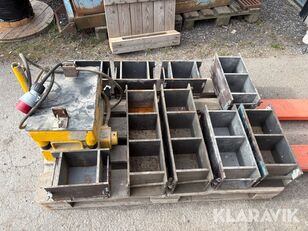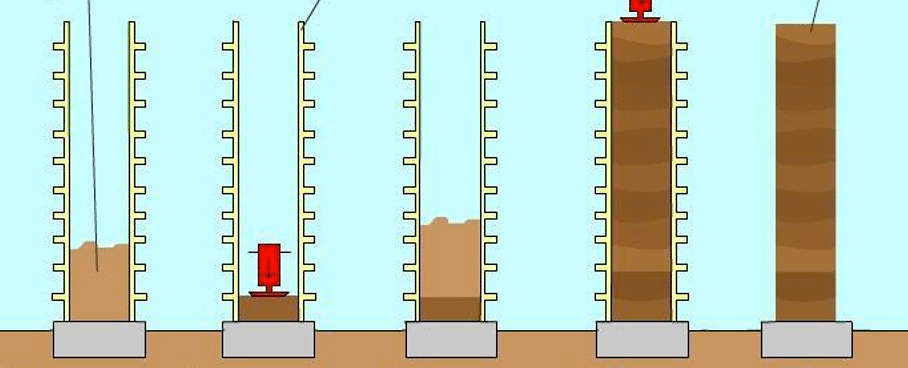Rammed Earth An Ancient Building Technique Redefining the Future of Architecture
Introduction
Imagine a house that breathes with you one that holds in the warmth of winter, keeps out the heat of summer, and feels like it’s part of the land itself. Sounds like a dream? It’s not. This is the reality of rammed earth construction .
This technique might seem modern, but its roots go back thousands of years. What’s new today isn’t the method itself, but how we can use it to build cities that are more sustainable, healthier, and more in harmony with nature. Rammed earth is no longer just an old tradition it’s becoming a source of inspiration for architects and engineers around the world.We review the stages of construction with rammed earth, from tradition to a sustainable future.



1. A Journey Through Time The History of Rammed Earth
Soil wasn’t just for farming people also used it as one of humanity’s earliest building materials. Long before concrete and steel, communities shaped walls from the earth beneath their feet. Over time, this simple practice evolved into a precise and durable technique known today as rammed earth
- Earliest Evidence :
The earliest recorded use of rammed earth dates back about 5,000 years , used by the Assyrian Empire . But soon after, it spread across civilizations from China to Spain and Morocco. - Global Adoption :
Whether in the homes of Andalusia, desert kasbahs in Morocco, or circular dwellings in China, rammed earth has always been present. Each region took the technique and added its own cultural touch, yet the result remained the same: strong, healthy buildings that blend with nature .
2. How Is Rammed Earth Built?
The process is simple, but it requires skill and attention to detail. No fancy machinery needed just good soil and careful craftsmanship. Here’s how it works:


1. Preparing the Soil
- Excavation on-site :
Often, the soil is taken directly from the construction site, reducing the need for transportation. - Mixing with water :
The soil is mixed with a calculated amount of water to create a thick, cohesive paste. The right balance between clay and sand is crucial:- Clay helps bind the mixture together.
- Sand adds strength and reduces cracking.
- Adding stabilizers :
To increase durability, additives like lime or even cement may be included. Some builders also use modern chemical stabilizers.

2. Pouring and Compacting
- Wooden forms are placed on both sides of where the wall will stand, and the soil mixture is poured in layers usually around 15–20 cm thick per layer.
- After each layer, the soil is compacted using manual tools or mechanical tampers. This step is essential to remove air pockets and ensure the wall is solid and uniform.
3. Removing the Forms
- Once the layers have settled and gained enough shape, the wooden forms are easily removed.
4. Final Protection
- Since raw earth isn’t fully waterproof, walls often need a protective coating against moisture.
- If the walls aren’t thick enough, an insulation layer might be added to improve thermal performance in extreme climates.


3. Why Rammed Earth is Eco Friendly
Rammed earth isn’t just natural it works with the environment instead of against it. Here are some key environmental benefits that make it ideal for today’s world:
| Eco Benefit | Why It Matters |
|---|---|
| Thermal Mass | Thick walls absorb heat during the day and release it at night, reducing reliance on heating and cooling systems. |
| Humidity Regulation | Earth naturally absorbs excess humidity and releases it when the air gets dry, improving indoor air quality. |
| Low Carbon Footprint | Unlike cement, rammed earth doesn’t require energy-intensive manufacturing, making it far less polluting. |
| Reusability | When a structure reaches the end of its life, the earth can be reused without harming the environment. |
| Affordable & Accessible | Materials are locally available, making it cost-effective and suitable for different project sizes. |
4. Real World Examples of Rammed Earth Use

Alhambra Palace Spain
One of the greatest examples of rammed earth in Islamic architecture. Built in the 13th century , Alhambra still stands tall today. Its walls aren’t just beautiful they withstand heat and humidity remarkably well.

Fujian Tulou China
In Fujian Province, communities still live in massive circular houses built from rammed earth. People recognize these centuries-old structures as UNESCO World Heritage sites. Their clever design offers natural protection from harsh weather and maintains a comfortable indoor climate throughout the year

Draa Valley Kasbahs Morocco
In southern Morocco, communities have built entire villages using rammed earth. Some of these structures date back to the 15th century and they still stand today, a testament to the durability and resilience of this ancient building technique.
5. Could Rammed Earth Be the Future of Construction?
It might sound surprising, but the answer is yes. In a world searching for smart, sustainable solutions, rammed earth offers a promising path forward. It’s:
- Eco-friendly : Low emissions and local resources reduce environmental impact.
- Healthy : Improves air quality and supports well-being.
- Cost-effective : Affordable and accessible, especially for communities building their own homes.
- Aesthetic : Adds a natural, timeless beauty to any project.
6. Conclusion
Rammed earth isn’t just a page from history it’s the start of a new chapter in architecture. It reminds us that innovation doesn’t always come from high-tech labs; sometimes, it comes from the ground we walk on.
ArchUp continues to track transformations in the construction sector, documenting projects that embrace innovation and show how people can build better, smarter cities.
If you’re looking for a building method that blends beauty, sustainability, and heritage, it might be time to rediscover the magic of rammed earth.







